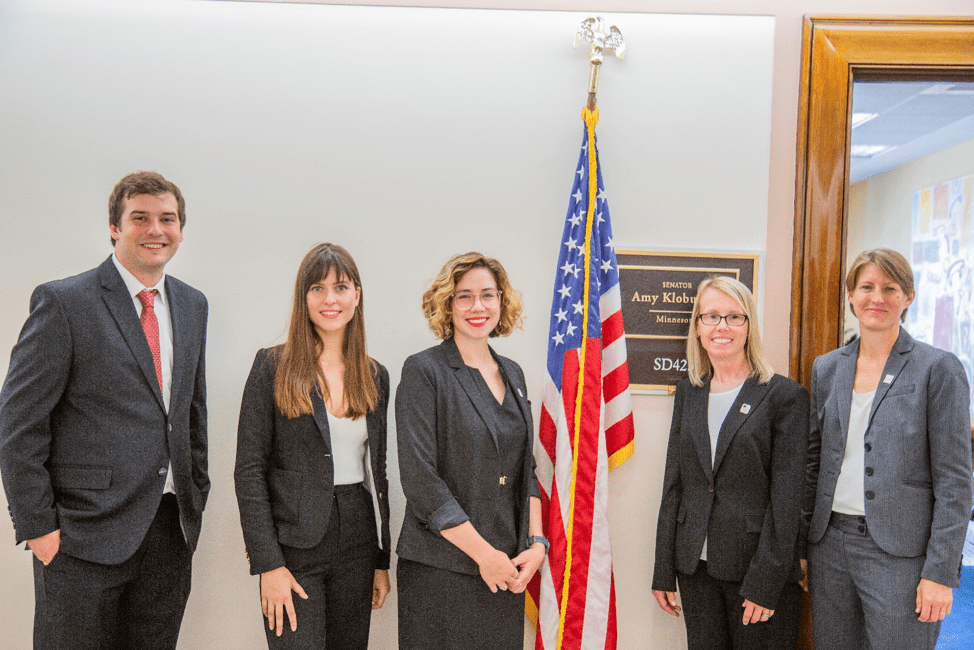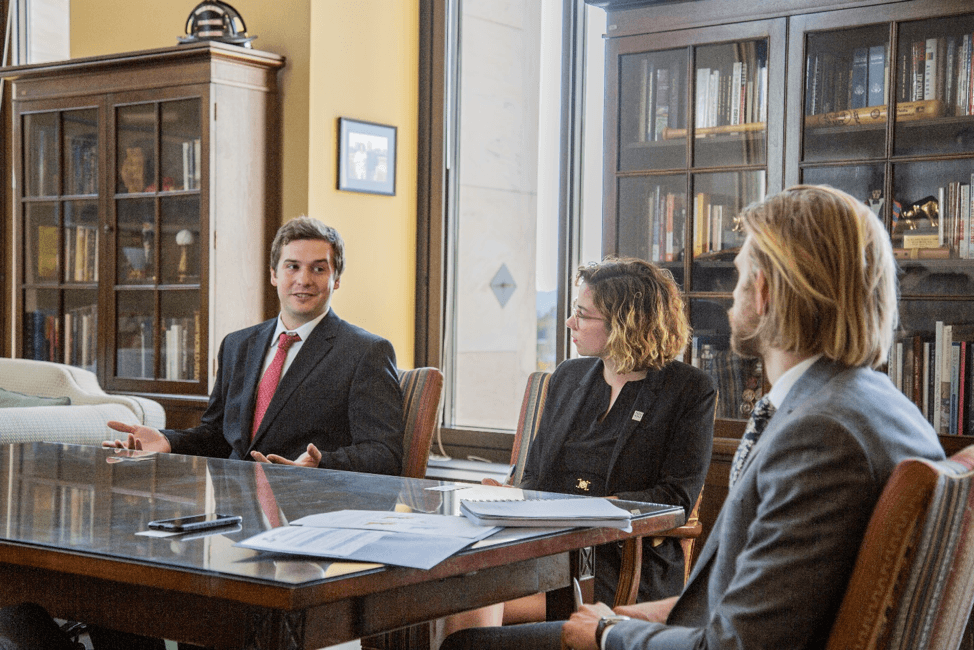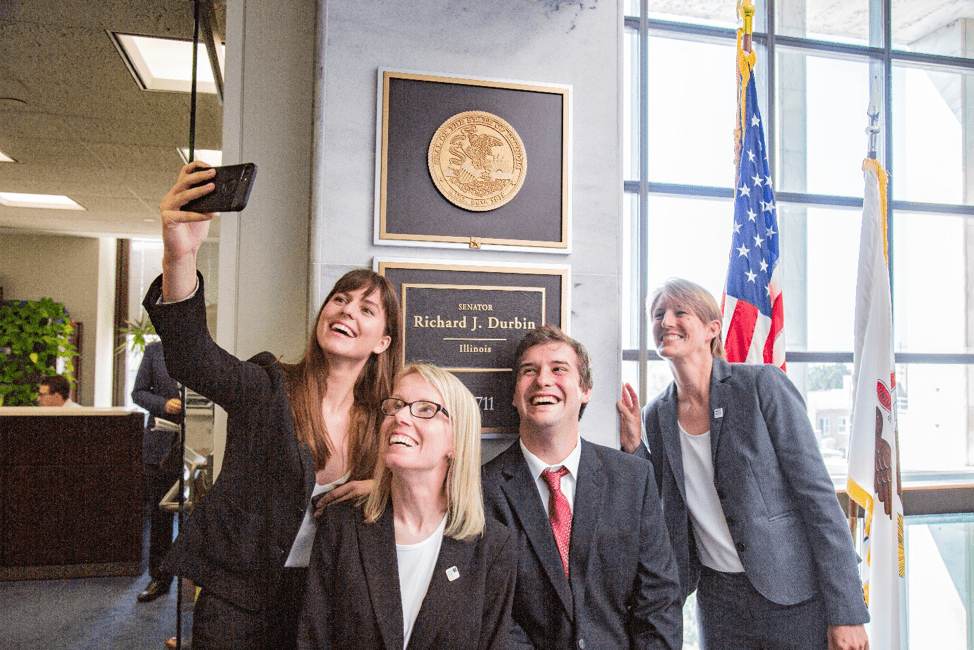A Paleontology Student Goes to Congress
 IL-MN group (left to right: Jason Coenen, Northern Illinois University; Stacy Montgomery, Northwestern University; Caitlin Bergstrom, American Geophysical Union; Candace Kaires-Beatty, Winona State University; Lisa Tranel, Illinois State University) waiting outside Amy Klobuchar’s office (D-MN).
IL-MN group (left to right: Jason Coenen, Northern Illinois University; Stacy Montgomery, Northwestern University; Caitlin Bergstrom, American Geophysical Union; Candace Kaires-Beatty, Winona State University; Lisa Tranel, Illinois State University) waiting outside Amy Klobuchar’s office (D-MN).
As a PhD candidate at Northern Illinois University, I’ve spent numerous hours in the lab and in classrooms communicating my science to geoscientists and non-geoscientists alike. When I saw the call for applications to participate in Geoscience Congressional Visits Days (GeoCVD) from the Paleontological Society, I knew it was an important opportunity.
Paleontology has been part of my life from a very young age. As a boy, I was obsessed with dinosaurs. This obsession quickly led to collecting shark’s teeth and sand dollars at the beach in Florida on vacation with my mom and looking for “fossils” in the woods of northern Wisconsin with my father. While that may not have been paleontology, per se, my curiosity regarding the natural world has graduated to researching dinosaurs and diatoms at the university level.
Paleontology is important to me. I feel that communicating its importance to family, friends, and fellow geoscientists is necessary because we are the timekeepers of the world. The study of past life gives us the opportunity to look back at a world that was much different than the world we live in today. Understanding how all systems on Earth interacted throughout time allows us to get a sense of what the future for our world might hold. Projections of future changes rely heavily on paleontological data to produce highly sophisticated models, that we use to inform policy makers and citizens alike (like those presented in IPCC reports).
GeoCVD was an opportunity to communicate the importance of paleontology and the research I do to a new group that I have only engaged with once before: members of Congress. When I was working at the United Parcel Service to help pay for my undergraduate degree, I wrote letters to Congress about workers’ rights and the importance of unions. It helped me feel like I had a voice in issues I thought were important to me. However, it wasn’t until GeoCVD that I realized the communication I was doing back then, and the communication I engaged in at GeoCVD, has such a significant role in the political process.
For those who don’t know, GeoCVD is an annual event hosted by the American Geosciences Institute (AGI) to bring geoscientists together on Capitol Hill to meet with congressional office staff. During these meetings, we present a series of prepared “asks” for our members of Congress to consider. For instance, my work on National Science Foundation (NSF) funded projects has benefited me in many ways, so I spoke about the importance of keeping funding at levels presented in the house budget as part of my “ask”. While this funding has done much for my career, the underlying political process and science policy to ensure that those funds were available seemed foreign. GeoCVD gave me the opportunity to learn more about those processes. Now, more than ever, I believe it is important for all scientists to discuss the work they are doing and demonstrate its significance to society. Otherwise, funding for scientific initiatives may not seem important to Congress.
 IL-MN group chatting with Kevin Lefeber (Legislative Assistant for Senator Dick Durbin).
IL-MN group chatting with Kevin Lefeber (Legislative Assistant for Senator Dick Durbin).
My main goals for attending this event were to improve my communication skills, highlight the significance of paleontology to society, learn about the underlying processes behind science funding, and bring attention to bills that are critical to my core values as a geoscientist. The preparation given to GeoCVD participants by AGI helped me reach these goals. Prior to travel to Washington DC, all participants took part in a webinar on how Congress works, what to expect, current geoscience-related bills, and how to frame our “asks” to Congressional staff. The webinar was very informative and proved beneficial.
Day one of the event started with a tour of the American Geophysical Union’s (AGU) building. The tour highlighted the sustainable technology they use to reach their goal of net zero emissions. It was truly amazing to walk through and see some of the sustainable technology firsthand. AGU is really doing their part to cut down on emissions. Through witnessing their leadership, I hope others will follow in their footsteps. After the tour ended, we signed in, sat down for lunch, and met our region-specific group members. I was part of the IL-MN group, which consisted of a mentor, two faculty members, and two graduate students. The keynote speakers were great and provided necessary information about programs, federal geoscience funding, and legislation. As a paleontologist, it was great to hear from Dena Smith (paleobiologist and EAR Program Director at NSF) about the NSF and some of the programs available for scientists to get involved in politics at the undergraduate level. As someone who aspires to be a professor mentoring both graduate and undergraduate student projects, it was very helpful to learn about alternate career and job opportunities for paleontologists outside of traditional field-based work.
Elizabeth Duffy (Seismological Society of America), gave an overview of federal geoscience funding, which was very well presented and, in some cases, a little scary. She presented the ideal “unicorn and rainbow” version of the budget process and then shared what actually happens. I really appreciated her honesty. After a short break, Laura Szymanski (Geological Society of America) walked us through some of the important geoscience specific bills and how to track them with congress.gov (an important resource for those interested). To wrap up the day there was a Q&A panel comprised of geoscientists that made the transition into political offices and a presentation by Julie McClure (Agronomy, Crop, and Soil Science Societies) on how to frame your “ask” and communicate with members of Congress and their staff.
Collectively, they highlighted four main points for success during our congressional meetings. The first was to “be memorable,” be respectful of everyone’s time, leave a business card, and be personable. The second main point was that staffers aren’t scary people: come ready to talk and know that staffers want to engage in the discussion just as much as you. Point three is a universal truth for all sciences: storytelling is important. Be very specific about how funding science agencies, or the bill you wish your member of Congress would support, will impact people. If possible, speak in terms of real-world experiences. The fourth and final point was to have a substantive “ask” by being clear and concise. The staffers and members of Congress are constantly moving from one meeting to the next; the clearer you can be, the better chance you have of spreading your message.
Day two involved meetings with congressional staff from 9am to 2:30pm. We met with staff from seven different offices: five offices from Illinois and two offices from Minnesota. Each meeting went by very fast (~15 minutes or less), but there was enough time for everyone to discuss their science and important talking points for each district. Meetings typically started with our mentor, Caitlin Bergstrom, explaining why we were there.
 IL-MN group taking a selfie outside Senator Dick Durbin’s office (D-IL).
IL-MN group taking a selfie outside Senator Dick Durbin’s office (D-IL).
Then each IL-MN group member briefly explained their research and exchanged business cards. The day before, we decided who would lead each discussion based on our voting district or other preference. Given that budgets were still being resolved in the Senate, and the House had to cut 10 billion dollars from the previous budget appropriations, we couldn’t have been there at a better time. We encouraged continued support for the scientific funding agencies NSF, NOAA, NASA, and the EPA. Not only had these agencies funded fieldwork or fellowship support for some of our IL-MN group members, but data sets from these agencies are crucial for our teaching. We stressed the importance of giving students hands-on learning material, like the data available from these agencies, to help build a highly-skilled workforce. Our other critical “asks” included endorsing bills (search for more info on congress.gov) such as the STEM Opportunities Act (H.R. 2528), the American Mineral Security Act (S. 1317), and the Digital Coast Act (H.R. 2189, S. 1069).
Regardless of political party, staffers were very engaged in discussions and were interested in keeping in touch with us as sources of expertise in our respective fields. To me, that was a very important message and highlights the power of engaging with our representatives. Staffers are completely open and willing to discuss bills and ideas they find important with their members of Congress. Finally, after moving quickly between meetings around Capitol Hill in a suit during a 100-degree heat index, it was nice to end the day in the air-conditioned Library of Congress.
This entire experience was very eye-opening. I appreciate everyone involved in preparing us and giving us a special glimpse into the role scientists have in policymaking in Washington DC. This experience has inspired me to keep in contact with my representatives and take a more active role in local politics. I hope to inspire others to take part in this experience because geoscience, including paleontology, needs to be heard and understood on Capitol Hill just as it is in the classroom, field, and laboratory
-Jason Coenen
Interested in learning more about Geoscience Congressional Visit Days (GeoCVD)? Applications are available each summer by late June, through the American Geosciences Institute. Want to know how you can help your Society engage in policy discourse? Take a look at our congressional blog posts for more information!

